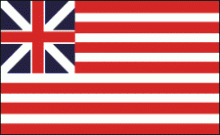|
American Flag |
The Grand Union Flag, also known as the Congress flag, the First Navy Ensign, the Cambridge Flag, and the Continental Colors, is considered to be the first national flag of the United States. This flag consisted of 13 red and white stripes with the British Union Flag of the time (prior to the inclusion of St. Patrick's cross of Ireland) in the canton. The flag was first flown on December 3, 1775 by John Paul Jones (then a Continental Navy lieutenant) on the ship Alfred in Philadelphia. The Alfred flag was used by the American Continental forces as a naval ensign and garrison flag in 1776 and early 1777. It is widely believed that the flag was raised by George Washington's army on New Year's Day 1776 at Prospect Hill in Charlestown (now part of Somerville), near his headquarters at Cambridge, Massachusetts, and that the flag was interpreted by British observers as a sign of surrender. The design of the Grand Union flag is similar to the flag of the British East India Company (BEIC). Indeed, certain BEIC designs in use since 1707 (when the canton was changed from the flag of England to that of Great Britain) were identical, although the number of stripes varied from 9 to 15. That BEIC flags were potentially well known by the American colonists has been the basis of a theory of the origin of the Grand Union flag's design. The Flag Act of 1777 authorized as the official national flag a design similar to that of the Grand Union, with thirteen stars (representing the original thirteen United States) on a field of blue replacing the British Union flag in the canton. Today the Grand Union flag is often included as the "first flag" in displays of United States flag history. |

